Introduction
Balanites aegyptiaca Del can reach a height of 6 to 9 m, it is ramous and thorny tree, also known as desert date in English.1 It belongs to the family of Zygophyllaceae. The tree is one of the most common but neglected wild plant species of the dry land areas. The tree grown in the arid region of sub-Saharan regions as well as in southern Asia and middle East, which is spiny evergreen.2 In those spaces where B. aegyptiaca plants are spread, the tree parts those are fruits, stem, root and leaf used for traditional folk medicines to treat various illness such as oral hypoglycemic drug.1,2 The flowers are greenish and grouped in small numbers at the axils of the leaves. The fruits are ovoid drupes 3 to 4 cm long, very angular, greenish when matured during ripening, light yellow when ripe.3,4,5 Chemical composition of desert date such as vitamins, alcohols, esters, aldehydes, ketones, saturated and unsaturated hydrocarbons likely responsible for its flavor were reported in Amadou.6 In addition, in the Sahel region the plant species only blooms in two periods of year that is September and March. Indeed, due to the local people food habit the fresh leaves together with flowers of B. aegyptiaca are well appreciated.6,7 They are eaten like those leaves of Moringa oleifera, Laptendania hastata or the Maerua classifolia. In the Sahel, the tree B. aegyptiaca is more utilized and recognized by the rural areas.8
The processing of the plant product for medicinal proposes was practiced of African for centuries. Thus, the usage of products from processed leaves, flowers, fruits, bark and roots of B. aegyptiaca were known for their virtues.9,10 However, the technologies of processing of these products of B. aegyptiaca for food in Africa remains traditional. Apart from the oil extraction which is more popular nowadays;4,11 the fresh leaves and flowers of B. aegyptiaca are consumed as food in the Sahel but the extract as result of cooking are not utilized even though known to be medicinal.2,5
Tea is an aromatic drink prepared by infusing dried leaves of tea tree, an evergreen shrub native to Asia. The tea tree or simply tea, (Camellia sinensis) is a shrub native to the Far East, family Theaacées. There are three types of these species cultivated all over the world: C. sinensis (Yunnan), C. sinensis assamica (Assam), and C. sinensis cambodiensis.12 Countries like China, Japan, Turkey, India, Kenya, Vietnam, Nepal, Tanzania, Taiwan and Sri Lanka are the main tea producers.13 Tea produced from the fresh leaves and flowers of B. aegyptiaca are now the new product as tea like.7 The demand for functional foods has led to the processing of underutilized plant organs such as B. aegyptiaca leaves, fruits and flowers known by the consumers for their health benefit as medicine than as a food. Such products are source of functional compounds like vitamins, antioxidants and more nutritive values. Research shows that desert date leaf are source of compound furanocoumarin, saponin, and flavonoid know as quercetin 3-glucoside, 3-rhamnogalactoside isorhamnetin, quercetin-3-rutinoside, 3-glucoside, 3-rutinoside, and 3-7-Diglucoside.4,6 They are also rich in vitamin C, carbides, aliphatic alcohols, sterols including nimbsterol or B-sitosterol and tannins.3,4 The composition of desert date fruit revealed to possess abundant nutritional benefit and peculiar flavor.6,14 Therefore, this work aimed to quantified the total phenols and flavonoids with LC-MS chemicals analysis. Furthermore, antioxidant activity and sensory evaluation of desert date flowers infusion were carried out.
Materials and Methods
Materials
The desert date (B. aegyptiaca) flowers tea (DDT) were collected in September 2018 from CERRA Maradi (Niger) Figure 1. The identification of plant material was carried out by the Institut National de la Recherche Agronomique du Niger (INRAN). Folin-Ciocalteu’s, 1,1-diphenyl-2-picrylhydrazyl (DPPH) reagent and gallic acid were purchased from Sigma-Aldrich, Inc. (Shanghai, China). The flavones narcissin, hirsutrin, quercetrin, ilixantrin, rutin, and isorhamnetin were purchased from Nanjing Zelang Biotech, Inc. (Nanjing, PRC). All other chemicals and regents used in this study were of analytical grade.
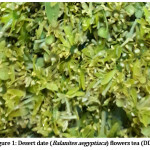 |
Figure 1: Desert date (Balanites aegyptiaca) flowers tea (DDT) Click here to View figure |
Methods
Samples preparation for total phenols and flavonoids contents
A 2.0 g dried DDT were crushed and extracted by 75% ethanol under ultrasound for 30 min, 0.2138 g extract were yield. The extract solution was tested for total phenols and total flavonoids contents accordingly. The tea was prepared following the method of Chin et al.14 where the ratio of 1/5 w/v of water to dry B. aegyptiaca tea was used for sensory evaluation. A coffee maker machine was used to make tea infusion for 5 min at ≈ 80 oC.
Total phenols
The content of total phenols of the DDT was determined by Folin-Ciocalteu method using gallic acid as a standard compound. The sample extract (0.2 mL) was mixed with 2.6 mL of deionized water, 2 mL of 7% (w/v) Na2 CO3, and 0.2 mL of the Folin-Ciocalteu reagent. After incubation at room temperature for 90 min, the absorbance of the reaction mixture was measured at 745 nm against the blank sample contained the same mixture solution without the sample extract (UV2300 Spectrophotometer, Shanghai-Tech comp) acordingly.15 Six-point calibration curve were used to determine the total phenolics using values obtained comparison with the calibration curve of gallic acid (Figure 2). Results were expressed as milligram gallic acid equivalents.
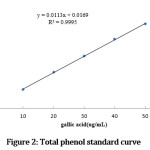 |
Figure 2: Total phenol standard curve. Click here to View figure |
Total flavonoids
The total flavonoids content of DDT was determined according as the aluminum chloride spectrophotometrically using aluminium chloride.16 An aliquot of 0.1 g of DDT was dissolved in 1 ml deionized water. This solution (0.5 ml) was mixed with 1.5 ml of 95% alcohol, 0.1 ml of 10% aluminum chloride hexahydrate (AlCl3), 0.1 ml of 1 M potassium acetate (CH3COOK), and 2.8 ml of deionized water. After incubation at room temperature for 40 min, the reaction mixture absorbance was measured at 415 nm against a deionized water blank on a spectrophotometer (UV2300 Spectrophotometer, Shanghai-Tech comp). Rutin was used as a standard. The flavonoids concentration (mg/mL) on the calibration line and the total flavonoid was expressed as milligram per gram of dry plants (Figure 3).
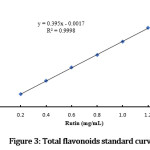 |
Figure 3: Total flavonoids standard curve. Click here to View figure |
Antioxidant Activity
According to the method of Thabit et al.,17 the DDT scavenging effect on 2,2-diphenyl-1-picrylhydrazyl (DPPH) free radical was measured. A different concentration of 2.0 mg/mL, 1.0 mg/mL, 0.5 mg/mL and 0.25 mg/mL was dissolved in 95% ethanol. After shaken the mixture and incubated for 20 min at room temperature, then the absorbance of the solution was read at 517 nm. Quercetin was used as positive control, also dissolved in ethanol at the concentration of 2.0 mg/L, 4.0 mg/L, 6.0 mg/L, 8.0 mg/L, 10.0 mg/L. The scavenging effect was expressed as follow:
![]()
The concentration of the plant extracts that caused 50% inhibition, called the inhibitory concentration or IC50.
LC-MS Analyses
The components of desert date flowers tea were analyzed using a developed High-Performance Liquid Chromatography system (Aglient) coupled to an AmaZon SL mass spectrometer (Bruker Daltonics) fitted with an electrospray ionization source operating in positive ionization mode and with an ion trap MS detector. The chromatographic separation occurred in a Phenomenex Luna C18 (5 µm, 150 mm × 4.6 mm) column, using a gradient from 5 to 100% MeOH over 20 min followed by 100% MeOH for 8 min, with a flow rate of 0.75 mL/min. Both solvents contained 0.1% formic acid. The column temperature was set to 40oC. (Ion source: ESI, voltage: 3,500 V, capillary temp.: 310oC, m/z range: 200–2000, gas pressure: 40 psi). The flavones in DDT were identified by comparing retention time and MS data.
Sensory Evaluation
The sensory analysis was performed on a panel of 19 panelists (semi-trained) composed of graduate students and academicians from the Department of crop production and Laboratory of Food Science and Technology at Dan Dicko Dankoulodo University, they were selected based on previous experience in sensory analysis. All the evaluators were used to tea consumption. The samples were subjected to an acceptance test, applying a hedonic scale of 5 points. A note of 0 to 5 scale (0 means not to like and 5 means excellent) has been awarded. The sample was tested according to the organoleptic characteristics (Appearance, taste, after taste, flavor, and general acceptability) used to evaluate the sensory attributes of the samples.
Statistical Analysis
All the experiments were conducted in triplicates. Microsoft office, Excel 2016 was used to analysis represent the data.
Results and Discussion
Results
The yields of total phenols and total flavonoids are shown in Figure 4 along with antioxidant activity of DDT. The content of total flavonoids was seven (7) times more than that of total phenols, 21.601mg rutin/g and 3.063 mg galic acid /g respectively (Figure 3). The results indicated substantial differences among the antioxidant activities of the extracts when compare to the quercetin as control. The IC50 value of the control happened to higher (4.04) than the IC50 value of DDT (1.07).
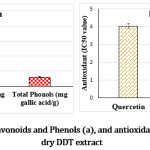 |
Figure 4: Total Flavonoids and Phenols (a), and antioxidant activity (b) of dry DDT extract. Click here to View figure |
The Figure 5a shows that out of five (5) parameters tested for the DDT along with green tea, appearance and taste were the most determinant characters that lead the general acceptability of samples. Flavor as popular descriptor of tea happened to be equal for both green tea and DDT; similarly, for the after taste. According to the panelists and their comments on these DDT, the results revealed differences between green tea and DDT. Especially, DDT happened to be an unusual sample to the panelists who are regular’s tea consumers. However, despite the unpopularity of DDT as tea but originated from a local known dish (dubagara) the results of sensory evaluation were satisfactory to extend that people are ready to accept the product due to its medicinal values.18 In both samples (DDT and green tea), the overall acceptability scores were 3.632±0.68 and 3.263±0.99 respectively for green tea and DDT. Apart the appearance and taste that are higher for the green tea, the overall acceptability of DDT seemed to be slightly lesser than that of green tea (Figure 5b) as described by the box and whisker diagram.
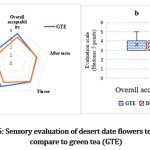 |
Figure 5: Sensory evaluation of desert date flowers tea (DDT) compare to green tea (GTE) Click here to View figure |
The chemical composition of the DDT analyzed by LC-MS techniques are shown in Figure 6. Six (6) molecules with their structure accounting for molecular weight from 317 to 663 ms of the DDT were found. All components were identified by differentiation of their retention time and mass spectrometry data with corresponding standards. Thus, narcissin, hirsutrin, quercetrin, ilixantrin, rutin, isorhamnetin and diverse flavone compounds were identified and presented in Figure 6.
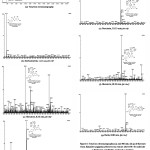 |
Figure 6: Total ion chromatography (a) and MS data (b-g) of flavones from Balanites aegyptiaca flowers tea extract where M+H: molecule + Hydrogen and M+Na: molecule + Sodium. Click here to View figure |
Discussion
The flowers picked from the tree are sometimes accompanied or contains small young leaves. These flowers are whitish greenish. There are 10 to 15 stamens, inserted on a dark green disk in the center of which is the pistil. Thus, this is what constituted the sample of this study (DDT) because often known as dubagara which is a flower-based food with small desert date young leaves cooked to satisfaction and consume after dripping which became the tea drink of this research. Generally, there are a variety of teas, including white, green, blue, black tea, or smoked. All from the same plant, only their treatment differs, and one in particular will have an impact on the nutritional and organoleptic quality. In addition, for the preparation, longer infusion time, more tannins will be predominant in concentration, making them bitter, or undrinkable tea for some. In addition, some teas require the addition of various types of additives to soften it as for example the honey or stevia.14
However, DDT is different to the ordinary tea that is known; it has significant organoleptic qualities. Besides, DDT when compare with commercial green tea, represent a natural infusion contrary to common tea where added additives help to improve some their intrinsic characters. Though, the evaluated intrinsic characters of DDT revealed to be significantly appreciated in exception of aftertaste where the consumers scored it less. This can be attributed to the complexity of interpreting sensory results. The strong variations in sensory properties from individuals to another maybe the difficulty to determine the source of these differences in rating. Such are differences in the understanding of the sensory descriptors, the origin of the panel composed of untrained people among them from food science major and differences in sensitivity of individuals (anosmia, hypogeusia and ageusia). For any marketable tea its quality evaluation varies due to the number of various factors, mostly its biochemical composition. It is said that both volatile compounds and chemical have positive association when it comes to sensory attributes of tea including overall acceptability.19 Odor or flavor are correlated or neglected with intensity of some food state; for example, Garskeo et al.,20 found this relationship between volatile compounds and heat-treated meat. Furthermore, these relationships are often difficult to interpret or are weak in nature, needing more analysis of data and meta-analyses.21 Data from this research corroborate with the work from Liang et al.,22 that estimated the quality of tea by chemical composition and colour difference analysis of tea infusions. More research has also demonstrated this trend of relationship between tea sensory quality and tea volatile components and chemical at the time of processing.23,24
Tea in all its variants are popular beverages with healthy role as a nutraceutical and pharmaceutical agent. It exists multiple and various tea brands produced from different parts of the world which are commercially available in the market; in this line they differed in their composition and quality which have an impact on their sensory qualities and storage.25 In addition, when the quality of the tea decreases and beneficial components are lost, the aroma of the product will also change. Thus, aroma for instance plays an important role in the evolution of sensory quality. However, this quality can be lost gradually during storage due to the influence of the humidity, temperature, sunrays and oxidation.26 Hassan et al..,27 observed in their study that chemicals (phenolics) in the plant’s parts are unequally concentrated; the leaves have more phenolics than the fruit-mesocarp. Indeed, content such as polyphenol and flavonoid present in the DDT are also found in other part of this plant extracts; moreover, compounds like quercetin with good antioxidant capacity in fruit also found DDT could be responsible for this function.6,28 The phenolic compound from the DDT has shown lower IC50 value antioxidant activity (Figure 4b) than that of quercetin; a flavonoid that influence the antioxidant activity. Furthermore, that phenolic compounds are mainly responsible for antioxidant activities.29,30,31
Conclusion
It is clear from this study on the biochemical composition of tea like from the desert date flowers revealed obvious characters. The sensory qualities of DDT have been appreciated by the panelists. The results of this study also revealed presence of several classes of compounds such as narcissin, hirsutrin, quercetrin, ilixantrin, rutin, isorhamnetin and diverse flavone likely responsible for antioxidant activity of beverage and responsible sensory characteristics. But many of taster after enjoying suggests to improve certain characteristics precisely the aftertaste. In addition, this work conveys more knowledge regarding the quality of this lesser known beverage present in Sahel. However, consumers form the panel recommended to improve certain sensory characteristics precisely the aftertaste.
Acknowledgements
Authors are grateful to Pr Le Guo Wei for technical assistance from his Food Nutrition Laboratory, JU, Wuxi, China.
Funding
The author(s) received no financial support for the research, authorship, and/or publication of this article.
Conflict of Interest
The authors do not have any conflict of interest with any person or organization in publishing this article.
References
- Hall J.B. Ecology of a key african multipurpose tree species Balanites aegyptiaca balanitaceae the state of knowledge. Forest Eco Manag. 1992; 50(1-2): 1-30. https://doi.org/10.1016/0378-1127(92)90311-V
CrossRef - Yadav J. Panghal M. Balanites aegyptiaca (L.) Del. (Hingot): A review of its traditional uses, phytochemistry and pharmacological properties. Int Jour Green Pharm. 2010; 4: 140-146. doi: 10.1055/a-0585-6153. Epub 2018 Mar 8.
CrossRef - Iwu M. M. Handbook of African medicinal plants. CRC press. 2014.
CrossRef - Chothani D. L., Vaghasiya, H. U. A review on Balanites aegyptiaca Del (desert date): phytochemical constituents, traditional uses, and pharmacological activity. Pharm Rev. 2011; 5(9): 55. doi: 10.4103/0973-7847.79100.
CrossRef - Sofowora A. Recent trends in research into African medicinal plants. Jour Ethnopharm. 1993; 38(2-3): 197-208. https://doi.org/10.1016/0378-8741(93)90017-Y
CrossRef - Amadou I. Date Fruits: Nutritional Composition of Dates (Balanites aegyptiaca Delile and Phoenix dactylifera). In: Simmonds, M.S.J., Preedy, V.R. (Eds.), Nutritional Composition of Fruit Cultivars. Academic Press, 2016; 215–233. https://doi.org/10.1016/B978-0-12-408117-8.00010-6
CrossRef - Manzo K.I. Transformation des fleurs et des jeunes feuilles de Balanites aegyptiaca en thé au Niger. Universite Dan Dicko Dankoulodo de Maradi. Memoire de licence professionnelle en agroalimentaire, Maradi, 2016 ; p. 35.
- Sagna M. B., Niang K. S., Guisse A., Goffner, D. Balanites aegyptiaca (L.) Delile: geographical distribution and ethnobotanical knowledge by local populations in the Ferlo (North Senegal)/Balanites aegyptiaca (L.) Delile: distribution géographique et connaissances ethnobotaniques des populations locales du Ferlo (nord Sénégal). Biotechnologie, Agronomie, Soc Environ. 2014; 18(4): 503. https://hal.archives-ouvertes.fr/hal-01722629
- Ugwah M. O., Ugwah-Oguejiofor C. J., Etuk E. U., Bello S. O., Aliero, A. A. Evaluation of the antiulcer activity of the aqueous stem bark extract of Balanites aegyptiaca L Delile in Wistar rats. Jour Ethnopharm. 2019; 111931. https://doi.org/10.1016/j.jep.2019.111931
CrossRef - Sofowora A. Research on medicinal plants and traditional medicine in Africa. The JourAltern Complem Med.1996, 2(3): 365-372. DOI: 10.1089/acm.1996.2.365
CrossRef - Amadou I., Mahamadou E. G., Tidjani A., Moutaleb O. H., Guo-Wei L. Functional and sensory properties of tuwan aduwa: a traditional meal made from foxtail millet and desert date extract. Nig Food Jour. 2017; 35(1): 1-7. https://www.ajol.info/index.php/nifoj/article/view/162700
- Zhao H., Zhang S., Zhang Z. Relationship between multi-element composition in tea leaves and in provenance soils for geographical traceability. Food Control. 2017; 76: 82-87. https://doi.org/10.1016/j.foodcont.2017.01.006
CrossRef - Kwach B. O., Owuor P. O., Kamau D. M., Msomba S. W., Uwimana M. A. Variations in the precursors of plain black tea quality parameters due to location of production and nitrogen fertilizer rates in Eastern African clonal tea leaves. Experim Agricul. 2016; 52(2): 266-278. DOI: 10.1017/S0014479715000083
CrossRef - Chin J. M., Merves M. L., Goldberger B. A., Sampson-Cone A., Cone, E. J. Caffeine content of brewed teas. Jour Anal Toxicol. 2008; 32(8): 702-704. DOI: 10.1093/jat/32.8.702
CrossRef - Arnnok P., Ruangviriyachai C., Mahachai R., Techawongstien S., Chanthai S. Determination of total phenolics and anthocyanin contents in the pericarp of hot chilli pepper (Capsicum annuum). Inter Food Res Jour. 2012;19: 235-243. http://ifrj.upm.edu.my/19%20(01)%202011/(31)IFRJ-2011-041%20Chantai.pdf
- Lin J Y. Tang C. Y. Determination of total phenolic and flavonoid contents in selected fruits and vegetables, as well as their stimulatory effects on mouse splenocyte proliferation. Food Chem. 2007; 101: 140-147. https://doi.org/10.1016/j.foodchem.2006.01.014
CrossRef - Thabit R. A. S., Cheng X. R., Tang X., Sun J., Shi Y. H., Le G. W. Antioxidant and antibacterial activities of extracts from Conyza bonariensis growing in Yemen. Pak Jour Pharm Sci. 2015; 28(1): 129. https://www.ncbi.nlm.nih.gov/pubmed/25553691
- Al-Thobaiti S., Abu Zeid, I. Medicinal Properties of Desert Date Plants (Balanites aegyptiaca)–An Overview. Global Jour Pharm. 2018; 12(1): 01-12. DOI: 10.5829/idosi.gjp.2018.01.12
- Adnan M., Ahmad A., Ahmed A., Khalid N., Hayat I., Ahmed I. Chemical composition and sensory evaluation of tea (Camellia sinensis) commercialized in Pakistan. Pak Jour Bot. 2013; 45(3): 901-907. http://www.pakbs.org/pjbot/PDFs/45%283%29/24.pdf
- Górska E., Nowicka K., Jaworska D., Przybylski W., Tambor K. Relationship between sensory attributes and volatile compounds of polish dry-cured loin. Asian-Australasian Jour An Sci.2017; 30(5): 720. https://doi.org/10.5713/ajas.16.0252
CrossRef - Chambers E., Koppel K. Associations of volatile compounds with sensory aroma and flavor: The complex nature of flavor. Molecul. 2013; 18(5); 4887-4905. doi:10.3390/molecules18054887
CrossRef - Liang Y., Lu J., Zhang L., Wu S., Wu Y. Estimation of black tea quality by analysis of chemical composition and colour difference of tea infusions. Food chem. 2003; 80(2): 283-290. https://doi.org/10.1016/S0308-8146(02)00415-6
CrossRef - Owuor P. O., Obanda, M. Comparative responses in plain black tea quality parameters of different tea clones to fermentation temperature and duration. Food Chem. 2001; 72(3): 319-327. https://doi.org/10.1016/S0308-8146(00)00232-6
CrossRef - Obanda M., Owuor P. O., Mang’oka R. Changes in the chemical and sensory quality parameters of black tea due to variations of fermentation time and temperature. Food Chem. 2001; 75(4): 395-404. https://doi.org/10.1016/S0308-8146(01)00223-0
CrossRef - Xu M., Wang J., Gu, S. Rapid identification of tea quality by E-nose and computer vision combining with a synergetic data fusion strategy. Jour Food Eng. 2019; 241: 10-17. https://doi.org/10.1016/j.jfoodeng.2018.07.020
CrossRef - Yu H., Wang Y., Wang J. Identification of tea storage times by linear discrimination analysis and back-propagation neural network techniques based on the eigenvalues of principal components analysis of e-nose sensor signals. Senso. 2009; 9(10): 8073–8082. doi:10.3390/s91008073
CrossRef - Hassan D.M., Anigo K.M., Umar I.A., Alegbejo J.O. Evaluation of phytoconstituent of Balanites aegyptiaca (L) del leaves and fruit-mesocarp extracts. MOJ Biorg Org Chem. 2017; (6): 228‒232. DOI: 10.15406/mojboc.2017.01.00039
CrossRef - Abou Khalil N. S., Abou-Elhamd A. S., Wasfy S. I., El Mileegy I. M., Hamed M. Y., Ageely H. M. Antidiabetic and antioxidant impacts of desert date (Balanites aegyptiaca) and parsley (Petroselinum sativum) aqueous extracts: lessons from experimental rats. Jour Diab Res. 2016; http://dx.doi.org/10.1155/2016/8408326.
CrossRef - Mhya D. H., Anigo K. M., Umar I. A., Alegbejo J. O. Evaluation of anti-hyperglycemic effect of sub-fractions derived from ethanol-aqueous fraction of Balanites aegyptiaca leaves in streptozotocin-induced diabetic rats. Asian Jour Biol Sci. 2019; 12: 164-172. DOI: 10.3923/ajbs.2019.164.172
CrossRef - Zapata M. B., Chaparro D., Rojano B. A., Alzate A. F., Restrepo L. F., Maldonado M. E. Effect of storage time on physicochemical, sensorial, and antioxidant characteristics, and composition of mango (cv. Azúcar) juice. Em Jour Food Agricul. 2017; 29(5): 367-377. doi: 10.9755/ejfa.2016-09-1256
CrossRef - Piluzza G., Bullitta S. Correlations between phenolic content and antioxidant properties in twenty-four plant species of traditional ethnoveterinary use in the Mediterranean area. Pharmaceutical Biol. 2011; 49(3): 240-247. doi: 10.3109/13880209.2010.501083
CrossRef

This work is licensed under a Creative Commons Attribution 4.0 International License.







